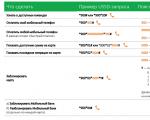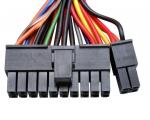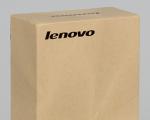Making speaker cabinets: Review of materials. DIY portable speaker in just a couple of days How to make portable speakers
Increasingly, in modern life we use a variety of portable gadgets. But more often than others, gadgets related to music playback are used. It is very convenient, while relaxing in nature or in the country, riding a bike or working out in the gym, turn on your favorite piece and enjoy high-quality sound. In this regard, portable speakers and boomboxes are very popular among many. Their cost varies from a few dollars to several hundred.
But some don't want to post it Nth amount for such a simple device and are wondering how to make a portable speaker with your own hands.
In this article we will talk about several options for its manufacture.
Before starting work, prepare the necessary materials, tools and equipment.
To make a portable speaker with your own hands you will need:

When working with these tools, do not forget to follow safety regulations.
DIY portable speaker housing
Let's start with making the body. The sound quality of speakers largely depends on the material of the housing. Plywood is ideally suited for these purposes, because it resonates well and, thanks to this, the sound is juicy, rich and with good bass. Just stuffing speakers into a cardboard box will never get you that way. high-quality sound like a plywood body. Case dimensions 180 x 70 x 60 mm. These are the optimal proportions for the best sounding speakers. We mark the plywood and cut everything out with a jigsaw. Drill holes for the speakers. Clean the edges with sandpaper. We glue all the parts with PVA glue, except for the front part with the holes for the speakers. We drill holes on it for the volume control and switch. We make holes for the micro-USB connector and the audio output wire. We cut out small squares (1 x 1 cm) from plywood and glue them into the corners of the body for further fastening of the lid.
Assembly
We solder the wires to the battery and insulate it with electrical tape. Solder the wires to the speakers. Please note that one contact is “+” and the other is “-”. Please keep this in mind when making future connections. We attach the lid, secure it with tape and drill holes with a diameter of 2.5 mm in the corners. Use an M3 tap to cut the thread.

We sand the entire body well with sandpaper. Carefully remove dust and paint. After the paint has dried, glue the speakers with hot glue. We screw the amplifier into the hole made earlier. Glue the switch. We solder the battery wires to the charge controller board in the places marked B+ and B-. Be careful not to reverse the polarity. At this stage, you can check the operation of the circuit by connecting a wire that indicates that charging is in progress. The blue LED will light up when the battery is fully charged. We solder the plus from the right speaker to the “ROUT+” contact, and the minus to the “ROUT-”. Similarly, solder the left speaker to the “LOUT” contacts. We solder the wires to the charge controller board with the “OUT+” and “OUT-32,” contacts. We glue the module with hot glue. We secure the battery. We pass the wire with the audio output into the hole made earlier. To protect against breakage, we tie a knot on it from the inside. Solder the wires coming out of the wire. Solder the remaining contacts to the switch and amplifier. We fasten the front panel with M3 bolts.
We connect the audio jack to the phone and check. Portable speaker ready for your phone with your own hands. It's not too difficult, especially if you're tech-savvy.
Let's move on. Next model We will assemble a portable one from improvised means. As a basis we will use the case with the speaker from the broken computer speaker and some materials purchased on AliExpress.
In addition, we will need:
- Decoder board (with its help you can play music not only from a USB flash drive, but also from SD cards and from your phone).
- Power controller for Li-ion batteries.
- Amplifier pam8403.
- Battery.
- 2 LEDs.
- 2 resistors 220 kOhm.
- 2 switches.
- Wires, including a wire with an audio output.
- 1 variable resistor 5 kOhm.
- Soldering accessories.
Circuit assembly
First, we solder the entire circuit, except for the input for the minijack and the button, to make it easier to insert into the case later. We use a Philips 1050 mA battery. The consumption of the board used is about 100 mA, so the battery will last for about 10 hours of operation.

Solder the power controller to the battery. After this, we solder the wires from the power controller to the decoder board through the switch. We repeat the connection with the amplifier. We solder the LED to the decoder board, and the LED to the amplifier board, passing through a 10 kOhm resistor. Don't forget about polarity. Now we solder the resistors. They are needed so that during playback there is less wheezing and extraneous sounds. We connect the board to the amplifier and start them one by one. If the LEDs light up and sound can be reproduced, then the circuit is assembled correctly.
Now you can solder a variable resistor to adjust the volume. Let's check. Turn on the power board and amplifier and turn the volume control.
Assembling the body
At the next stage, we will assemble the circuit and body of the portable speaker with our own hands. Let's disassemble the column. Unsolder the groove of the wire holder. We drill a hole in the case for a minijack with a diameter of 3.5 mm. We make holes for LEDs, volume control, buttons and a USB connector. We glue the decoder board inside the case. Before attaching the buttons, use a soldering iron or a hair dryer to unsolder the original buttons on the decoder board. We check the operation of the column and assemble the housing. Your handmade portable speaker is ready.

If you are the owner of golden hands and a bright head, then this article will definitely be useful to you. You can make your own DIY portable speaker for three times less than what it costs in the store. And have fun while doing it.
In today's article we will try to look in detail at how to do wireless speaker. The advantage of this homemade product compared to similar homemade products is that we will assemble it using ready-made cheap Chinese modules. And we won’t have to solder any complex circuits, and anyone, even a child, can assemble such a homemade product. By assembling this homemade product, you will not only get a cool and high-quality wireless speaker, but most importantly, improve your skills with a soldering iron, solder, etc. I would also like to add that our assembly, which is described below, can be further improved, namely by adding a Bluetooth module to it. In general, the homemade product is very interesting, so let’s not delay with a long introduction, let’s go!
For this homemade product we will need:
- Frame. Any, but it is better to use wood, such as plywood
- Two speakers 1.5 inch 3W 4 Ohm
- Audio wires (but ordinary ones are also possible)
- PAM8403 module (audio amplifier)
- MP3 decoder, or otherwise player
- 18650 battery
- Switch
- Battery control board
We will also need the following tools:
- Soldering iron
- Solder
- Wire cutters
- Super glue
- Hot-melt adhesive
- Jigsaw
Well, let's start assembling. To begin with, we should take probably the most important elements of a homemade product, namely the speakers. You can find a link to a suitable option at the end of the article. But I will still repeat that the speakers should be 3W with a resistance of 4 ohms. The speaker data should be connected to Pripyat with two wires no longer than 15 cm. In order not to get confused, I recommend using colored wires.


The next step is that we need a housing in which we will actually assemble our homemade product. It can be of absolutely any shape and from any material. But for acoustics it is best to use a wooden case. We will use thin plywood. The author of the homemade product used a CNC laser machine for cutting plywood to make the necessary holes and to cut the plywood itself. If you don’t have one, then you can get by with an ordinary hand jigsaw. To begin, we will cut out a rectangle from a sheet of thin plywood, which will serve as the front panel of the homemade product. The size of this rectangle should be approximately the same as in the photo below. In the cut-out rectangle, two round through holes should be made, with a diameter slightly smaller than the outer diameter of the speakers. Then we connect the speakers with a piece of plywood. Joining should be done with hot-melt glue, but epoxy-based glue is also perfect for this.





After which we will need to take an audio amplifier that is suitable for our speakers, namely, we need the PAM8403 amplifier, a link to which you will also find at the end of the article. TO this module you should solder the wires that were previously soldered to the speakers. Soldering should be done observing the polarity “+” to “+”, and “-” to “-”, on the most printed circuit board amplifier and on the speakers, the polarity is indicated at the required contacts and therefore it will be difficult to confuse them. As a result, at this stage we should have a design as shown in the photo below.



Next, we will need to take a module such as an MP3 decoder (player), a link to it is also left at the end of the article. In fact, our Chinese friends have a very large selection of such players, with different prices and functionality, choose any one that you can afford and one that suits you in terms of characteristics. The wires from the 4-pion cable from the MP3 decoder should be soldered to our audio amplifier as follows. Namely with reverse side There are five contacts relative to the previously soldered wires. A yellow wire should be soldered to the contact with the symbol “L”, a white wire to the contact with the symbol of an inverted “T”, and a green wire to the contact with the symbol “R”. And we solder the black and red wires to the “-” and “+” contacts, respectively.





Then we will need to take an 18650 battery, this format batteries are very common, and finding them anywhere will not be difficult. It should be noted that for correct and safe operation of the battery, a special control board should be used, which will monitor the charge and discharge of the battery, which will extend the battery life. Two wires no longer than 15 cm should be soldered to the battery. Batteries should be soldered very quickly without allowing them to overheat, otherwise they will simply fail.



The wires just soldered to the battery should be soldered to the battery control board, namely to the contact marked “B+” and “B-”, to “B+” the positive wire, and to “B-” the negative wire, respectively. After that, two wires no longer than 10 cm should be soldered to the contacts on the board with the symbols “OUT+” and “OUT-”. After that, we solder the wires coming from the battery control board (those that we just soldered) to the “+” and “-” contacts on the amplifier, that is, “OUT+” to “+”, and “OUT-” to “-” .




Next, we should cut out the same rectangle from plywood that was cut out at the very beginning (it could be wider) and glue it with super glue to the rectangle cut out at the beginning, as shown below. This plywood rectangle will serve as the bottom of the structure. Then another exactly the same rectangle, but only with a hole for an MP3 decoder. And we will also glue this rectangle using superglue to the opposite side (see photo).


We install the MP3 decoder in its seat after first removing the cable. And fix the MP3 decoder with superglue, then install the cable back. An audio amplifier should also be glued to the inside of the case so that it does not dangle there. Let's cut out another wooden rectangle similar to those before, and to this rectangle using hot glue we should glue the battery and its control board. And glue this rectangle to the place indicated in the photo.









Next, from the same plywood we should cut out a square with holes for the switch, power connector and air flow passage. And glue it on the side where we glued the battery control board (by inserting the wires through the holes under the switch). Next, we solder the switch to the inserted wires and install it in its mounting hole. At the end, we will cut out the same square from plywood as with the holes, but without them. And glue it on the opposite side (see photo).







That's all! Everything is ready, all that remains is to charge the battery, insert an SD card with music of a supported format into our speaker and enjoy the music.
Themselves ordinary horn loudspeakers and did not have a body as such. Everything changed when speakers with paper cones appeared in the 20s of the 20th century.
Manufacturers began making large cases that housed all the electronics. However, until the 50s, many audio equipment manufacturers did not completely close the speaker cabinets - the back remained open. This was due to the need for cooling electronic components of that time (lamp equipment).
Stone
The most commonly used stones are marble, granite and slate. Slate is the most suitable material for making cabinets: it is easy to work with due to its structure and it absorbs vibrations effectively. The main disadvantage is that special tools and stone processing skills are required. To somehow simplify the work, it may make sense to make only the front panel from stone.It is worth noting that to install stone speakers on a shelf, you may need a mini-crane, and the shelves themselves must be strong enough: the weight of a stone audio speaker reaches 54 kg (for comparison, an OSB speaker weighs about 6 kilograms). Such enclosures seriously improve sound quality, but their cost can be prohibitive.
The speakers are made from a single piece of stone by the guys from Audiomasons. The bodies are carved from limestone and weigh about 18 kilograms. According to the developers, the sound of their product will appeal to even the most sophisticated music lovers.
Plexiglass/glass
You can make a speaker housing out of transparent material - it's really cool when you can see the "insides" of the speaker. Only here it is important to remember that without proper insulation the sound will be terrible. On the other hand, if you add a layer of sound-absorbing material, the transparent case will no longer be transparent.A good example of high-end acoustic equipment made from glass is the Crystal Cable Arabesque. Cases of Crystal Cable equipment are made in Germany from strips of glass 19 mm thick with polished edges. The parts are fastened together with invisible glue in a vacuum installation to avoid the appearance of air bubbles.
At CES 2010, held in Las Vegas, the updated Arabesque won all three awards in the field of Innovation. “Until now, no equipment manufacturer has been able to achieve true hi-end sound from acoustics made from such a complex material. – wrote the critics. “Crystal Cable has proven that it can be done.”
Laminated timber/wood
Wood makes good cases, but there are some things to consider here: important point: wood has the property of “breathing”, that is, it expands if the air is humid and contracts if the air is dry.Since the wooden block is glued on all sides, tension is created in it, which can lead to cracking of the wood. In this case, the housing will lose its acoustic properties.
Metal
Most often, aluminum is used for these purposes, or more precisely, its alloys. They are light and tough. According to a number of experts, aluminum can reduce resonance and improve transmission high frequencies sound spectrum. All these qualities contribute to the growing interest in aluminum from audio equipment manufacturers, and it is used for the manufacture of all-weather speaker systems.There is an opinion that making an all-metal case is not a good idea. However, it is worth trying to make the top and bottom panels, as well as the stiffening partitions, from aluminum.
Hello to all DIYers! Once I saw a broken portable MP3 speaker in a friend’s garage. The son said he “repaired it” and was going to throw it away. There were no internals, no power supply, no batteries, but I really liked the wooden case, and the speakers seemed to be intact. I decided to revive her and take her with me to the forest for picnics.
And then the work began to boil; I took a Chinese MP3 module for 200 rubles as the source.

I took a 7.4 volt 1200 mA battery from the quadcopter, it didn’t draw a quad anymore, but it was just right for this project. The amplifier was taken from a computer speaker on a TDA2282 chip - a good and proven 1-watt stereo chip. ULF circuit below.
Amplifier circuit

I removed the variable from the board and the headphone jack, replaced the 1000 uF output capacitors, and put 0.22 uF + a 33 kohm resistor at the input, since its sensitivity is very strong. I connected it to the battery and the module - everything started playing perfectly.



Instead of the front panel, I cut out a plate from fiberboard and covered it with black self-adhesive. I attached a suitable 11-volt transformer to the back wall, secured the battery, and brought the balancing connector for charging out - I will charge it with the stock charger from the quadcopter. From the battery and transformer, power is supplied to the device through diodes so that there is no dependence. The LEDs for illumination were burned out, so I installed other multi-colored ones from lighters. During the assembly process, glue from a hot-melt gun was used.


I liked the sound: loud, powerful, most suitable for nature. I tested the duration of operation at medium volume - the device played continuously for 4 hours, then distortion appeared, and although I could no longer read MP3s, the radio was still working. The battery voltage was 4.8 V.
At first the idea arose to buy a powerful mobile Bluetooth speaker, but branded JBL ones cost up to $300, and their power rarely exceeds 40 watts, so it was decided to start assembling my own. The “boombox speaker” was based on a TDA7492P UMZCH module with a power of 2x50 W and a Li-Ion battery with a total voltage of 21 V and a capacity of 3500 mAh (70 W).

Most of the parts were ordered from the well-known AliExpress website, including the speakers. While the batteries are being charged with a separate IMax charger, in the future it will be necessary to make a ready-made Charger in the building itself.

The speakers are two broadband speakers with a power of 25 W each and two high-frequency speakers with a power of 10 W each, which gives us a total of 70 W, but in peaks they can handle 100 W. The manufacturer of these speakers is the little-known Aiyima, but the quality of their performance and sound quality was a pleasant surprise, which allows us to recommend it for assembling small speakers. Their parameters are as follows:
- Frequency range range: 81 – 5400 Hz
- Sensitivity: 87 dB
- F res. about 115 Hz
A USB module has been added as a Power-Bank. The body is made from 10mm thick MDF and measures 12x12x27cm. It was glued together with wood glue and also reinforced with screws on each side, except for the plate on the back which was glued in place with hot glue in case any repairs or modifications were needed.
Testing a homemade speaker
Tests have shown that these two full-range speakers, unfortunately, are not fully capable of reproducing the entire frequency range, so 10 W tweeters were installed along with them. The HF speakers were connected in series with film capacitors.

As for the bass amplifier on the TDA7492 (the sound is received bluetooth module 4.1), the sound quality is very good and clear. The only problem with this board is that the speakers are slightly noisy when listening to music quietly. There is a solution to this problem on the Internet; only a slight modification of the board is required, but this is not particularly disturbing.

The housing must be very sealed, otherwise the pressure inside the speaker causes air to escape through small holes, which causes unpleasant “farts” from the speaker.

Cost of all assembly costs
- TDA7492P 2x50w 10$
- USB converter 0.8$
- Bluetooth receiver $2
- 5S Lithium-Ion battery 2.5$
- MDF 10mm approx. 1$
- Speakers 3″ ShP $36
- Speakers 1.5″ HF $12
- Battery 18650 packaging Panasonic 3400 mAh 5x4$
- Plus wires, switches, capacitors: $70 total


The TDA7492 microcircuit is, the circuit operates in the range of 8-25 V, so 21 V is not the limit - you can supply 6 cans. According to the specification per m/s at THD 10%, the total is almost 100 watts of power.




